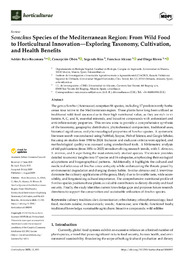Título :
Sonchus species of the Mediterranean Region: from wild food to horticultural innovation—exploring taxonomy, cultivation, and health benefits |
Autor :
Ruiz Rocamora, Adrián
Obón, Concepción
Ríos, Segundo
Alzaraz, Francisco
Rivera, Diego |
Editor :
MDPI |
Departamento:
Departamentos de la UMH::Biología Aplicada |
Fecha de publicación:
2025 |
URI :
https://hdl.handle.net/11000/38284 |
Resumen :
The genus Sonchus (Asteraceae) comprises 98 species, including 17 predominantly herbaceous
taxa native to the Mediterranean region. These plants have long been utilized as
traditional wild food sources due to their high nutritional value, as they are rich in vitamins
A, C, and K, essential minerals, and bioactive compounds with antioxidant and
anti-inflammatory properties. This review aims to provide a comprehensive synthesis
of the taxonomy, geographic distribution, phytochemical composition, traditional uses,
historical significance, and pharmacological properties of Sonchus species. A systematic
literature search was conducted using PubMed, Scopus,Web of Science, and Google Scholar,
focusing on studies from 1980 to 2024. Inclusion and exclusion criteria were applied, and
methodological quality was assessed using standardized tools. A bibliometric analysis
of 440 publications (from 1856 to 2025) reveals evolving research trends, with S. oleraceus,
S. arvensis, and S. asper being the most extensively studied species. The review provides
detailed taxonomic insights into 17 species and 14 subspecies, emphasizing their ecological
adaptations and biogeographical patterns. Additionally, it highlights the cultural and
medicinal relevance of Sonchus since antiquity while underscoring the threats posed by
environmental degradation and changing dietary habits. Sonchus oleraceus and S. tenerrimus
dominate the culinary applications of the genus, likely due to favorable taste, wide accessibility,
and longstanding cultural importance. The comprehensive nutritional profile of
Sonchus species positions these plants as valuable contributors to dietary diversity and food
security. Finally, the study identifies current knowledge gaps and proposes future research
directions to support the conservation and sustainable utilization of Sonchus species.
|
Palabras clave/Materias:
culinary tradition
diet
domestication
ethnobotany
ethnopharmacology
local food
modern cuisine
nutraceuticals
weeds
Asteraceae
functional foods
sustainable agriculture
bioactive compounds |
Tipo de documento :
info:eu-repo/semantics/article |
Derechos de acceso:
info:eu-repo/semantics/openAccess
Attribution-NonCommercial-NoDerivatives 4.0 Internacional |
DOI :
https://doi.org/10.3390/horticulturae11080893 |
Publicado en:
Horticulturae 2025, 11, 893. |
Aparece en las colecciones:
Artículos - Biología Aplicada
|
 La licencia se describe como: Atribución-NonComercial-NoDerivada 4.0 Internacional.
La licencia se describe como: Atribución-NonComercial-NoDerivada 4.0 Internacional.
.png)
